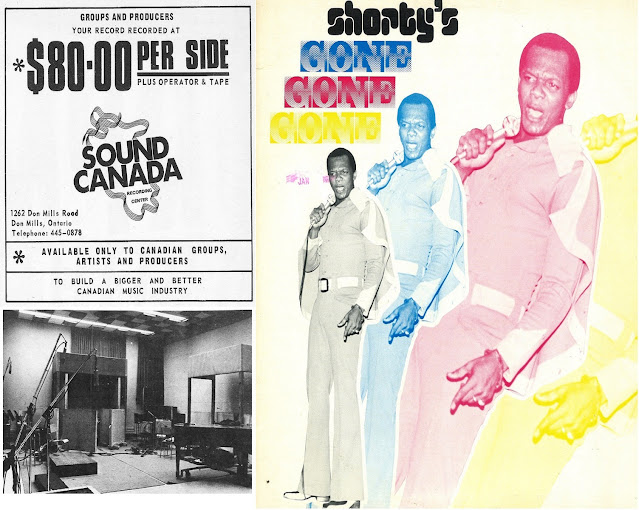Toronto has long been a haven for immigrants of all shades and stripes. Working-class and white-collar individuals from many nations converged on the Canadian metropolis throughout the 20th century, building it into the city we know today. Surely one of the most musical of these migrations was the mass exodus from the Caribbean region to Ontario, Canada, during the 1950s, 1960s, and early 1970s. This placed Toronto and the GTA (Greater Toronto Area) at the forefront of the developing soca, reggae, and funk genres. Today we'll tell the story of one such band, The New Directions, whose stint as a backing group for Lord Shorty brought them to the precipice of soca music's debut. The story and identity of The New Directions have remained a mystery for five decades, stumping many a music historian. With a bit of luck and intuition, I recently unearthed something.
*IF ANY BAND MEMBERS SEE THIS PLEASE CONTACT ME AT: CANADIANCULTCLASSICS@GMAIL.COM*
The New Directions were formed in Toronto sometime between 1970 and 1972. Many of the members traveled to Toronto from the Caribbean during the mid-to-late 1960s, after which they got day jobs and began to play on the city's local music scene. From what I can dig up, Henry Antoine was the driving force in getting the band together.
A drummer, percussionist, and cultural consultant, Henry was on the beat from the second his plane touched down at Toronto's Pearson International Airport in 1968. Henry devoted himself to improving the social and cultural quality of life of his fellow Caribbean immigrants in Toronto. In addition to this, Henry got involved in the early planning and performance of the Caribana Festival, quickly moving up the ranks by 1970.
During 1972, Henry Antoine began working as a producer and engineer at Art Snider’s Sound Canada Recording Centre. He put together The New Directions as a backing band for his productions, with musicians he met during his various philanthropic endeavors in Little Jamaica and the Caribbean community of Toronto. The members of the band included Ralph Moore (organ/keyboards/vocals), Elton Grant (guitar/backing vocals), Glenrick Cox (drums), Henry Antoine (producer/congas/backing vocals), Michael Sheperd (bass/backing vocals), Bunny Bynoe (cowbell/tambourine), Wayne Jackson (trumpet), Oswald James (trombone), and Michael Skel [Redhead] (tenor saxophone). Ralph Moore and Henry Antoine also acted as arrangers for various sessions.
While in Trinidad, Lord Shorty was a respected recording artist and worked with Ed Watson and his Brass Circle band through the late 1960s, recording a half dozen singles between 1964 and 1971. Shorty performed calypso throughout his career, experimenting with adding Indian-inspired flavors to the music.
Henry Antoine began managing Lord Shorty in Toronto and paired him with The New Directions band. They began performing live around Toronto and set to work recording the bulk of what would become Shorty's debut album." "He wanted to do this thing called soca."He said it had an infectious beat, with the rhythm to move your soul. It didn't make much sense at the time, but he was nagging at me, and he wouldn't stop until I took him to the studio," says Henry.
With no synthesizers available to the recording crew, they hired actual string players, which was a first for a calypso album at the time. The music Lord Shorty played was sharply different from the slow melodies of typical calypso music, and it came as a shock to everyone. "It didn't make sense to me because it was something new. But once we started recording, it started to sink in that what we were doing was something revolutionary."
After a brief period in Toronto, Lord Shorty's debut album "Gone Gone Gone" was released in Canada (c. 1973), bringing soca music into the world. Of the ten songs, nine were originals by Lord Shorty. Three songs were recorded back in Trinidad with Ed Watson and his Brass Circle band, but seven of the ten tracks were recorded in Toronto with The New Directions. Though the album wasn't a success in Canada, copies of the album made it back to Trinidad and other parts of the Caribbean, where fans devoured the new music. Lord Shorty asked The New Directions to tour with him, but they chose to stay in Toronto.
The New Directions continued to perform around the greater Toronto area throughout 1973 and early 1974. Their sound was a blend of popular soul/funk/R&B covers, as well as band originals, mostly written by organist and lead vocalist Ralph Moore. Through Henry Antoine's relationship with Sound Canada owner Art Snider, The New Directions were recommended to Artie Kohn. Artie was a record store owner, band manager, photographer, and producer who decided to start Vintage Records in Toronto during 1971. With recording and manufacturing done at Art Snider's Sound Canada Recording Centre, Artie signed bands, recorded them, and sold their records (usually pressed in LP quantities of 500 and 45s of 200 to 250) in his Village Record Shop [ADDRESS UNKNOWN].
Artie Kohn signed The New Directions to a two-single deal and sent the band into Sound Canada to record with Henry Antoine doing double duty as producer and percussionist. The band's debut single "Trolley/I Can Understand" and sophomore single "Directions/Wildflower" were released simultaneously during the spring of 1974 and sold exclusively at Artie Kohn's Village Record Shop. No promo was done, and the singles have become quite rare in the present day. The singles represent a great cross-section between funk and soul music. The originals "Trolley" and "Directions" (A-side on each release, respectively) are instrumentals written by band organist/lead vocalist Ralph Moore. The covers "I Can Understand" and "Wildflower" (B-side on each release, respectively) are vocal tracks. Canadian music fans may note the funky rendition of Skylark's "Wildflower," then a charting hit for that band.
Original Photos/Audio Courtesy of MOCM - Museum of Canadian Music (http://Citizenfreak.com)



